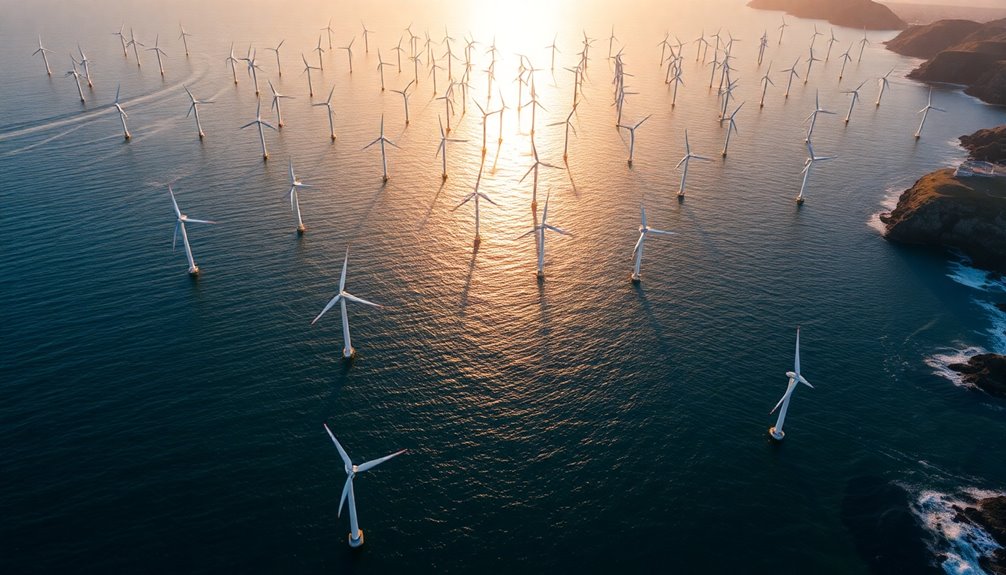The world's top ocean energy production zones feature impressive power densities, especially in Florida and South Africa, where potential energy extraction far exceeds many other areas. These regions benefit from shallow waters and optimal conditions for harnessing energy from tides, currents, and waves. However, the development faces challenges, including environmental impacts and high costs. Understanding these dynamics can provide deeper insights into ocean energy's future. Stick around to discover more about these promising locations and their potential.
Key Takeaways
- Florida and South Africa are leading regions with ocean power densities exceeding 2,500 watts per square meter.
- Southeast U.S. and parts of Africa are particularly suited for energy production due to favorable conditions.
- Approximately 490,000 square kilometers of ocean features high-power density areas ideal for energy extraction.
- Seasonal variations impact energy availability, with warmer months providing higher energy levels.
- Data limitations in regions like South Africa and Brazil complicate energy assessments for ocean energy projects.

As global energy demand continues to rise, the oceans present a promising solution for clean energy through various forms of ocean energy, including currents, waves, and tides. You'll find that ocean currents, waves, and tidal energy are the primary sources driving this renewable energy revolution.
While ocean energy is still in its early stages compared to more established technologies like solar and wind, its potential is vast, particularly in regions with high power densities.
Ocean energy, though nascent compared to solar and wind, holds immense promise in high power density regions.
Look at places like Florida and South Africa, where power densities exceed 2,500 watts per square meter. These areas, characterized by relatively shallow waters, enhance the feasibility of extracting energy using turbines. Unlike regions such as Japan and parts of South America, which have lower power densities, Florida and South Africa stand out as prime locations for ocean current energy production.
You should also consider seasonal variations, as warmer months typically yield higher energy availability. Moreover, identifying feasible locations for ocean current energy projects is crucial for development and can significantly influence the success of harnessing this potential.
Recent studies have assessed ocean current energy globally, utilizing over 30 years of NOAA's Global Drifter Program data. Remarkably, about 75% of high-power density areas show energy levels between 500 and 1,000 watts per square meter, covering around 490,000 square kilometers of ocean.
You'll note that the Southeast U.S. and parts of Africa are particularly suited for energy production due to these power densities.
However, the journey toward harnessing ocean energy isn't without challenges. Identifying economically viable locations remains a significant hurdle.
Data limitations in regions like South Africa and Brazil can complicate energy assessments, while variable water conditions can affect power density accuracy. Plus, environmental impacts and high costs compared to conventional energy sources pose additional barriers.
As you explore the possibilities of ocean energy, remember that overcoming these challenges is crucial for its widespread adoption in the quest for cleaner energy solutions.
Frequently Asked Questions
How Is Ocean Energy Different From Traditional Renewable Energy Sources?
Ocean energy stands out from traditional renewables like solar and wind due to its consistent, 24/7 availability.
While solar and wind rely on weather conditions, ocean waves and currents provide a more stable energy source. Tidal power, with its predictable cycles, offers further reliability.
Additionally, ocean energy can complement these other sources, ensuring a balanced energy grid. This unique reliability makes ocean energy an essential player in the renewable landscape.
What Are the Environmental Impacts of Ocean Energy Production?
Ocean energy production can significantly impact the environment.
You might notice disruptions in marine wildlife and habitats, affecting feeding and migration patterns. Noise pollution from installation can stress marine mammals, while visual alterations can change coastal landscapes, impacting tourism.
Additionally, the risk of collisions with devices poses threats to marine life.
You'll find that strategic siting and thorough environmental assessments are crucial in mitigating these effects and protecting our oceans.
Who Are the Leading Companies in Ocean Energy Technology?
When you look at leading companies in ocean energy technology, you'll find innovators like Eco Wave Power and Carnegie Clean Energy, focusing on wave energy solutions.
Sinn Power and Wave Swell Energy also contribute with their modular platforms and unique technologies.
AWS Ocean Energy and CorPower Ocean are pushing the boundaries of wave energy, while research institutions like Florida Atlantic University are crucial for advancing ocean current technologies.
Together, they're shaping the future of renewable energy.
What Challenges Does Ocean Energy Face in Global Adoption?
Ocean energy faces several challenges in global adoption.
You'll notice high initial costs and limited infrastructure can deter investment. Complex regulations slow down project development, while variable marine environments require tailored solutions.
Competing industries complicate marine space usage, and extreme weather puts additional strain on technology.
Market uncertainties and a lack of public awareness further hinder growth, making it crucial to address these barriers for ocean energy to thrive.
How Can Individuals Support Ocean Energy Initiatives?
You can support ocean energy initiatives in several ways.
Start by educating yourself and others about its benefits; awareness can drive demand for clean energy.
Consider advocating for local projects or policies that promote ocean energy development.
If you're able, invest in community-based renewable energy projects or support organizations working in this field.
Lastly, participate in workshops and forums to engage with experts and express your support for sustainable energy solutions.
Conclusion
As you explore the world's top ocean energy production zones, you'll uncover a treasure trove of potential, waiting to be harnessed like a hidden pearl beneath the waves. These vibrant regions, where the dance of tides and currents creates a symphony of renewable power, remind us that our oceans hold the key to a sustainable future. So, let's dive in and embrace the waves of change, turning the tides toward a cleaner, brighter tomorrow.









